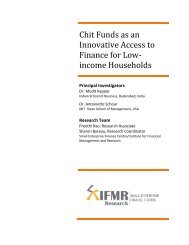Government of India Volume I: Analysis and Recommendations
Government of India Volume I: Analysis and Recommendations
Government of India Volume I: Analysis and Recommendations
You also want an ePaper? Increase the reach of your titles
YUMPU automatically turns print PDFs into web optimized ePapers that Google loves.
Table <strong>of</strong> <strong>Recommendations</strong> 7.5 Powers <strong>of</strong> the resolution corporation as receiver<br />
RESOLUTION<br />
If a covered service provider fails to implement the instructions <strong>of</strong> the micro-prudential regulator <strong>and</strong> the resolution<br />
corporation under the prompt corrective action framework, <strong>and</strong> reaches a stage <strong>of</strong> “imminent risk to viability,” the<br />
regulator will appoint the resolution corporation as receiver <strong>of</strong> that covered service provider. As a consequence <strong>of</strong><br />
being appointed as receiver <strong>of</strong> a covered service provider, the resolution corporation will have the following powers:<br />
1. To act as successor to all rights, titles, powers, <strong>and</strong> privileges <strong>of</strong> the covered service provider;<br />
2. To take over the management <strong>of</strong> the covered service provider;<br />
3. To exercise any <strong>of</strong> the three major tools to resolve a covered service provider: sale to another financial service<br />
provider, the incorporation <strong>of</strong> a bridge institution, or temporary public ownership (nationalisation);<br />
4. To manage <strong>and</strong> operate the covered service provider including selling <strong>of</strong>f its assets, arranging for the assumption<br />
<strong>of</strong> its liabilities, <strong>and</strong> conducting the business <strong>of</strong> the covered service provider; <strong>and</strong><br />
5. The resolution corporation as receiver shall terminate all rights <strong>and</strong> claims that the shareholders <strong>and</strong> creditors<br />
<strong>of</strong> the covered service provider may have against the assets <strong>of</strong> the company, except for the right to payment,<br />
resolution, or other satisfaction <strong>of</strong> their claims.<br />
The resolution process must be allowed to proceed smoothly, with appropriate immunity from legal proceedings<br />
pending the completion <strong>of</strong> resolution. In law, this requires m<strong>and</strong>ating the following:<br />
1. The decision to resolve a covered service provider, as determined by the resolution corporation, is final, conclusive<br />
<strong>and</strong> may not be appealed;<br />
2. A court will not have jurisdiction over any claim or any action seeking a determination <strong>of</strong> rights with respect to<br />
the assets <strong>of</strong> the covered service provider, including any assets which the resolution corporation may acquire<br />
as receiver; <strong>and</strong><br />
3. Throughout the exercise <strong>of</strong> its functions, the resolution corporation must be bound by a clearly defined legal<br />
process. If it strays from this process, it may be open to challenge before the tribunal.<br />
Table <strong>of</strong> <strong>Recommendations</strong> 7.6 Tools <strong>of</strong> resolution<br />
The draft Code on resolution enables the resolution corporation to exercise at least three types <strong>of</strong> resolution tools:<br />
1. Resolution by purchase<br />
◮ The resolution corporation can merge a failing covered service provider with another financial service<br />
provider(s), or transfer some <strong>of</strong> its assets <strong>and</strong> liabilities to another financial service provider; <strong>and</strong><br />
◮ The resolution corporation must ensure that there is thorough due diligence, <strong>and</strong> there is minimal<br />
disruption caused to the consumers <strong>of</strong> the service providers concerned.<br />
2. Resolution by bridge service provider<br />
◮ The resolution corporation can create a wholly-owned bridge institution to which all or some <strong>of</strong> the<br />
assets <strong>and</strong> liabilities <strong>of</strong> a failing covered service provider may be transferred;<br />
◮ This tool may be exercised if, given the size <strong>and</strong> complexity <strong>of</strong> the covered service provider, it is infeasible<br />
to sell it to another institution directly; <strong>and</strong><br />
◮ This tool may also be exercised if the resolution corporation determines that the continued operation<br />
<strong>of</strong> the covered service provider is essential to provide financial services in the market.<br />
3. Resolution by temporary public ownership<br />
◮ As a last resort, the resolution corporation may require temporary public ownership <strong>of</strong> a failing covered<br />
service provider in order to maintain financial stability;<br />
◮ This tool should be used only when all other options have been exhausted;<br />
◮ Temporary public ownership should typically be used for a SIFI, including banking service providers,<br />
where the risk <strong>of</strong> firm failure is a threat to the financial system;<br />
◮ The resolution corporation must consult <strong>and</strong> obtain the permission <strong>of</strong> the FSDC in the exercise <strong>of</strong> this<br />
tool; <strong>and</strong><br />
◮ Since the tool has large fiscal implications, the draft Code must limit the conditions when the tool can<br />
be exercised.<br />
<strong>and</strong> a wholly owned subsidiary <strong>of</strong> a foreign firm will be identical from the viewpoint <strong>of</strong><br />
resolvability.<br />
In the existing legislative l<strong>and</strong>scape, there are certain Acts such as the State Bank <strong>of</strong><br />
<strong>India</strong> Act, 1955 <strong>and</strong> the Life Insurance Corporation Act, 1956, that were enacted to create<br />
specific financial institutions. These laws contain provisions that vary or exclude the applicability<br />
<strong>of</strong> general corporate <strong>and</strong> financial laws to the institutions created under them.<br />
For instance, the State Bank <strong>of</strong> <strong>India</strong> Act, 1955 exempts the State Bank <strong>of</strong> <strong>India</strong> from the<br />
76 FINANCIAL SECTOR LEGISLATIVE REFORMS COMMISSION



